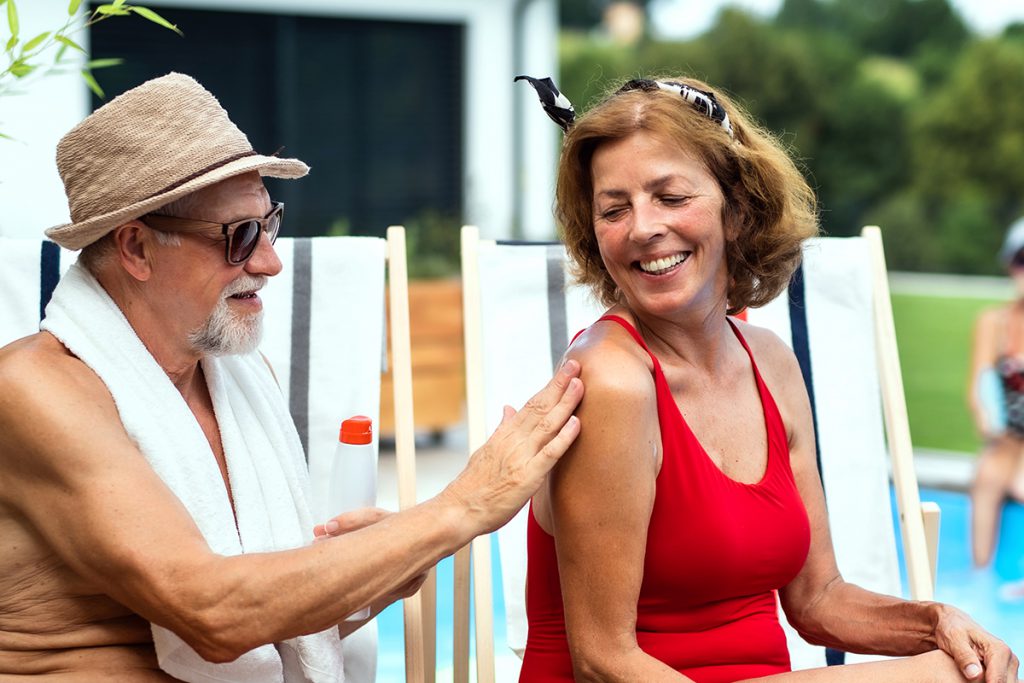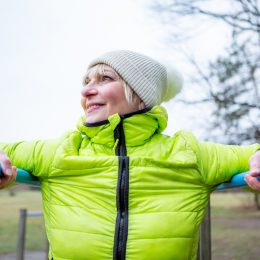What a Skin Cancer Expert Wants Older Adults to Know About Sunscreen
To protect against skin cancer, you need to know which sunscreen is right for you. Safeguard your skin with these sunscreen facts.

Did you slather on sunscreen today? About half of older adults forgo sunscreen during a day in the sun, according to the Centers for Disease Control and Prevention (CDC).
The incidence of melanoma — a deadly type of skin cancer — increases with age, which is why it’s so important to protect your skin. In fact, in research where dermatologists performed skin examinations on adults between the ages of 70 and 93, one quarter were found to have skin cancer or precancer of the skin, according to a 2022 BMC Geriatrics study.
The culprit is ultraviolet (UV) rays, which are present on both sunny and cloudy days. There are two types that reach your skin: UVA rays, which contribute to skin aging and wrinkles, and UVB rays, which cause sunburn and skin cancer, according to the United States Environmental Protection Agency (EPA).
Proper sun protection lowers your risk for skin cancer, including basal and squamous cell carcinomas (the two most common) and melanoma.
But if you step into a drugstore, you know how overwhelming the sunscreen choices can be. Here’s what you need to know to keep your skin healthy, straight from a skin cancer pro.
Add SilverSneakers to your wellness routine! Classes and events are happening daily at participating gyms, online through SilverSneakers LIVE, and at community centers near you. Activate your free online account to get started.
What SPF do I need?
Look for SPF 30 for daily use, says dermatologist Elizabeth Hale, M.D., senior vice president of the Skin Cancer Foundation. But if your skin is especially susceptible to sunburn or you have a history or high risk of skin cancer, it can’t hurt to go higher.
The SPF number indicates how long you would take to get sunburn compared to not using sunscreen, according to the Skin Cancer Foundation. (So if you wear SPF 30 exactly as directed, it will take 30 times longer to get a sunburn than if you went without sunscreen.)
The foundation recommends wearing a water-resistant SPF 30 during outdoor activities. Lather it on 30 minutes before you go outside. And don’t forget to reapply, either every two hours or immediately after swimming or sweating.
You should also look for the words “broad spectrum” on your sunscreen bottle. Broad-spectrum coverage signifies that the product is suited to protect against both UVA and UVB rays. You can find both of these terms on the front label of the product.
What sunscreen ingredients should I look for?
Generally, there are two types of active ingredients in sunscreens: chemical and mineral ingredients.
Chemical ingredients work by absorbing UV rays, according to the American Academy of Dermatology (AAD). The most common active chemical ingredients you’ll see listed on labels are:
- Avobenzone
- Oxybenzone
- Octocrylene
- Octinoxate
Mineral-based (or physical) sunscreens create a shield that bounce UV rays off of skin, according to the AAD. The two main minerals are:
- Titanium dioxide
- Zinc oxide
Both types of sunscreens have their pros and cons. For example, mineral sunscreens are great for sensitive skin types, but some can apply a bit chalky and white. That said, formulations have come a long way, and many now contain transparent zinc oxide that goes on sheer and smooth.
The choice is ultimately yours. “Both physical and chemical sunscreens are safe and effective,” says Dr. Hale. She recommends using a sunscreen with zinc oxide for everyday use, particularly for the face, to provide broad-spectrum coverage. Zinc oxide formulas are also gentle and non-irritating and are tolerated well by everyone, she says.
If you’re doing outdoor activities that involve sweating or swimming, you may be better off with a chemical-based sunscreen. “These offer better sweat and water resistance,” she says. Look for “water-resistant” on the label, which will also tell you how many minutes it’s water resistant. For example, if it says 80 minutes, you’d want to reapply again after 80 minutes of swimming.
Should I choose a stick, spray, powder, or lotion sunscreen?
Sunscreens come in a variety of applications. “My personal preference is for the base layer to be a lotion or cream, which offers more even coverage,” says Dr. Hale. “The spreadability is important.”
After your base coat, you can then reapply with powder (for the face) or spray (for the body), as both can make it easier to add another layer. A sunscreen stick is best saved for smaller areas, like your forehead or nose.
If you have issues with dexterity or grip, a sunscreen lotion with a pump dispenser is key. You can dispense the product by pressing down on the pump, says Dr. Hale. That means no need to squeeze the bottle or open the cap.
What’s the best way to apply sunscreen?
You can’t rely on sunscreen to protect you from UV rays if you don’t apply it correctly. One of the most common sunscreen errors? Not using enough. Here’s the right way to apply different types of sunscreens.
Lotion. The AAD recommends using one ounce (a shot glass) of sunscreen lotion to cover your body. Apply it to all exposed skin and rub it in until it’s absorbed. That includes the parts of your body you might overlook, like your ears and the tops of your feet. If you have thin hair, you can apply sunscreen to your scalp or wear a hat.
Spray. When spraying on sunscreen, it can be tough to tell whether you’ve used enough. That’s why the AAD suggests holding the nozzle close to your skin and spraying it until your skin glistens. Then rub it in thoroughly. Some other tips: Don’t use spray sunscreen on windy days and avoid inhaling it. And never apply spray sunscreen near heat, an open flame, or while smoking.
Stick. Don’t just run the stick over your skin one time. The AAD recommends applying four passes back and forth to ensure you’re using enough. Then rub it into your skin with your fingertips.
No sunscreen protects against 100 percent of the sun’s UV rays. In addition to wearing sunscreen, practice other sun safety measures like:
Subscribe to our newsletter
It's quick and easy. You could be one of the 13 million people who are eligible.
Already a member? Click to discover our 15,000+ participating locations.
Follow Us
- Seeking out shade
- Wearing broad-brimmed hats
- Wearing sunglasses with 100 percent UV protection
- Wearing long-sleeved shirts and long pants
See our sources
Risks of not using sunscreen: Centers for Disease Control and Prevention
Skin cancer in older population: BMC Geriatrics
UV rays: United States Environmental Protection Agency
SPF overview: Skin Cancer Foundation
Sunscreen ingredients overview: American Academy of Dermatology
How to apply lotion sunscreen: American Academy of Dermatology
How to apply spray and stick sunscreen: American Academy of Dermatology
Check Your SilverSneakers Eligibility Instantly
SilverSneakers members can go to thousands of gyms and fitness locations across the nation, plus take SilverSneakers LIVE online classes that are designed for seniors of all levels. If you have a Medicare plan, it may include SilverSneakers—at no additional cost. Check your eligibility instantly here.
Already a member? Get your SilverSneakers member ID and exclusive fitness content by activating your online account here.
Not eligible for SilverSneakers? You can still get 200+ free SilverSneakers On-Demand videos and stay in touch with us by creating your online account.





